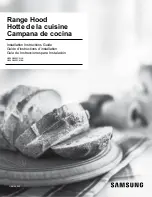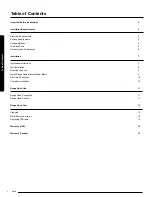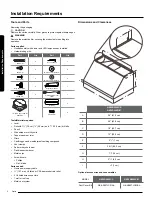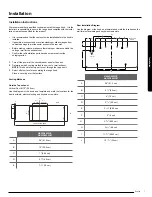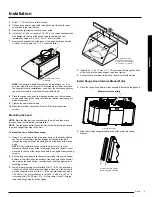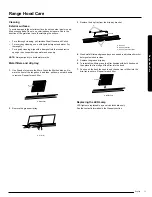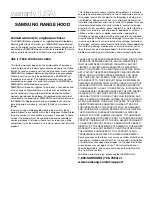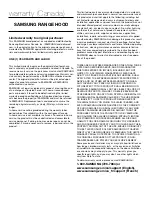
English
5
Electrical Requirements
IMPORTANT
Observe all governing codes and ordinances.
It is the customer’s responsibility:
To contact a qualified electrical installer.
If codes permit and a separate ground wire is used, it is recommended
that a qualified electrician determine that the ground path is adequate.
A copy of the above code standards can be obtained from:
National Fire Protection Association
1 Batterymarch Park
Quincy, MA 02169-7471
CSA International
8501 East Pleasant Valley Road
Cleveland, OH 44131-5575
■
A 120 volt, 60 Hz., AC only, 15-amp, fused electrical circuit is required.
■
If the house has aluminum wiring, follow the procedure below:
1.
Connect a section of solid copper wire to the pigtail leads.
2.
Connect the aluminum wiring to the added section of
copper wire using special connectors and/or tools designed
and UL listed for joining copper to aluminum.
■
Follow the electrical connector manufacturer’s recommended
procedure. Aluminum/copper connection must conform with local
codes and industry accepted wiring practices.
■
Wire sizes and connections must conform with the rating of the
appliance as specified on the model/serial rating plate. The model
serial plate is located behind the filter on the rear wall of the range hood.
■
Wire sizes must conform to the requirements of the National Electrical
Code, ANSI/NFPA 70 (latest edition), or CSA Standards C22. 1-94,
Canadian Electrical Code, Part 1 and C22.2 No. 0-M91 (latest edition)
and all local codes and ordinances.
Venting Requirements (ducted models only)
•
Vent system must terminate outdoors.
•
Do not terminate the vent system in an attic or other enclosed area.
•
Do not use a 4” (10.2 cm) laundry-type wall cap.
•
Use metal vent only. Rigid metal vent is recommended.
Plastic or metal foil vent is not recommended.
•
The length of the vent system and the number of elbows should
be kept to a minimum to provide efficient performance.
For the most efficient and quiet operation:
•
Use no more than three 90° elbows.
•
Make sure there is a minimum of 30” (76.2 cm) of straight vent
between the elbows if more than 1 elbow is used.
•
Do not install 2 elbows together.
•
Use clamps to seal all joints in the vent system.
•
The vent system must have a damper. If the roof or wall cap
has a damper, do not use the damper supplied with the range
hood.
•
Use caulking to seal the exterior wall or roof opening around the cap.
•
The size of the vent should be uniform.
Venting Methods
To use the hood’s top outlet to vent your hood, a 10” (25.4 cm) round
vent system is required.This vent systems are not included and must be
purchased separately.
NOTE
Flexible vent is not recommended. Flexible vent creates back pressure
and air turbulence that greatly reduce performance. The vent system can
terminate either through the roof or wall. To vent through a wall, a 90°
elbow is needed.
Mounting Height
Mount the hood no less than 30” (76.2 cm) above an electric cooking
surface, no less than 32” (81.2 cm) above a gas cooking surface, and no
higher than 36” (91.4 cm) above either surface.
Horizontal discharge
A 90° elbow may be installed immediately above the hood.
Horizontal Discharge
Vertical Discharge
A
B
C
A
B
C
A. 10” (25.4 cm) round vent
B. 10” (25.4 cm) round transition
C. 90º elbow
A. 10” (25.4 cm) round transition
B. 10” (25.4 cm) duct
C. Cabinet
Installation Requirements
Installation Requirements

